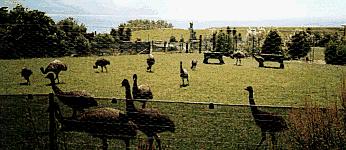![]()
 I drove past a fenced-in yard with 12-15 emus. It was in a residential
area and I was quite surprised to see them there. It didn't look like a
barnyard, but instead was a well manicured lawn that just happened to
house all those birds. They were as curious about me as I was about
them and came running to the 6 ft. high fence as soon as I stopped my
bike. They seemed smaller than the ones we've seen in the wild, so I
wonder whether they are domesticated. I intend to find out.
I drove past a fenced-in yard with 12-15 emus. It was in a residential
area and I was quite surprised to see them there. It didn't look like a
barnyard, but instead was a well manicured lawn that just happened to
house all those birds. They were as curious about me as I was about
them and came running to the 6 ft. high fence as soon as I stopped my
bike. They seemed smaller than the ones we've seen in the wild, so I
wonder whether they are domesticated. I intend to find out.
![]() I had read about a limeestone cave called The Maori Leap Cave. lt's on
the South Bay side of the peninsula, so I headed for that. A 40 min.
tour started soon after I arrived. It was discovered in 1958 as
bulldozers for a limestone quarry came upon it by accident. Geologists
estimate it was cut off from the sea around 6000 years ago. Fossils
inside the cave are aged at 6000 to 1 million years old. It's a young
cave by some standards and about 300 feet long. The name Maori Leap
comes from an old legend that the cliff under which this cave is tucked
was a lovers' leap. I learned that Kaikoura sits on a major fault and
experiences over 30 minor earthquake tremors a day and an average of
390 major tremors per year. It made me eager to get out of that cave.
I had read about a limeestone cave called The Maori Leap Cave. lt's on
the South Bay side of the peninsula, so I headed for that. A 40 min.
tour started soon after I arrived. It was discovered in 1958 as
bulldozers for a limestone quarry came upon it by accident. Geologists
estimate it was cut off from the sea around 6000 years ago. Fossils
inside the cave are aged at 6000 to 1 million years old. It's a young
cave by some standards and about 300 feet long. The name Maori Leap
comes from an old legend that the cliff under which this cave is tucked
was a lovers' leap. I learned that Kaikoura sits on a major fault and
experiences over 30 minor earthquake tremors a day and an average of
390 major tremors per year. It made me eager to get out of that cave.
![]()
Smithsonian Giant Squid Overview Page
gene carl feldman / gene@seawifs.gsfc.nasa.gov